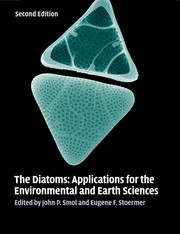Book contents
- Frontmatter
- Contents
- List of contributors
- Preface
- Part I Introduction
- Part II Diatoms as indicators of environmental change in flowing waters and lakes
- Part III Diatoms as indicators in Arctic, Antarctic, and alpine lacustrine environments
- Part IV Diatoms as indicators in marine and estuarine environments
- Part V Other applications
- Part VI Conclusions
- 36 Epilogue: reflections on the past and a view to the future
- Glossary, acronyms, and abbreviations
- Index
- References
36 - Epilogue: reflections on the past and a view to the future
from Part VI - Conclusions
Published online by Cambridge University Press: 05 June 2012
- Frontmatter
- Contents
- List of contributors
- Preface
- Part I Introduction
- Part II Diatoms as indicators of environmental change in flowing waters and lakes
- Part III Diatoms as indicators in Arctic, Antarctic, and alpine lacustrine environments
- Part IV Diatoms as indicators in marine and estuarine environments
- Part V Other applications
- Part VI Conclusions
- 36 Epilogue: reflections on the past and a view to the future
- Glossary, acronyms, and abbreviations
- Index
- References
Summary
The preceding chapters provide a summary of the major advances (and challenges) related to the application of diatoms to environmental and earth-science issues. A simple comparison between the content and diversity of chapters published in the first edition of this book in 1999 and the current volume should provide considerable satisfaction to practitioners and users of these data. Although many challenges remain, progress has clearly been made on many fronts. Nonetheless, and at the risk of ending the book on a pessimistic note, we re-iterate below some of our concerns about the lack of progress and resources dedicated to some of the more basic and fundamental issues related to diatoms.
In the previous edition of this book, we were so bold as to attempt an assessment of future directions in diatom research applications. It seems appropriate, and perhaps humbling, to assess those prognostications and their implications for future directions. Our (1999) statement that “It is very clear that a good deal of effort needs to be devoted to the formalities of taxonomy and nomenclature, which have been sadly neglected for the past century” remains virtually unchanged today. In fact, our enthusiasm for the “great strides (that) have been made very recently in the alpha level taxonomy of diatoms” has proven to be rather naive. Significant increases in taxonomic resolution have certainly been made, partially through application of objective techniques, such as cladistic analysis and numerical shape analysis, but perhaps more importantly through simple, but more thorough, exploration of a much wider range of regions and habitats.
- Type
- Chapter
- Information
- The DiatomsApplications for the Environmental and Earth Sciences, pp. 611 - 613Publisher: Cambridge University PressPrint publication year: 2010

